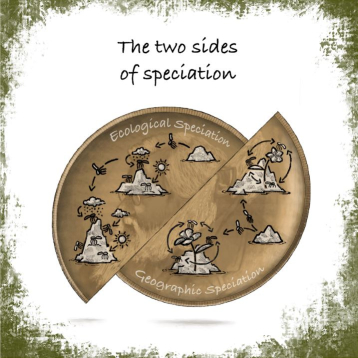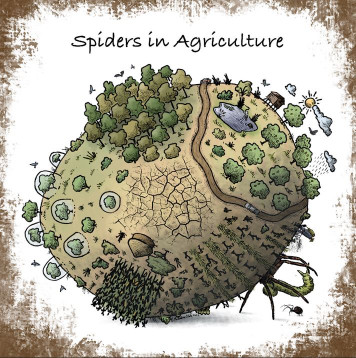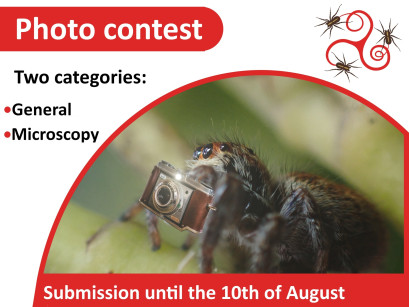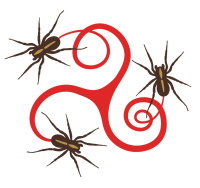New : Découvrez les illustrations du congrès par Jagoba Malumbres-Olarte :
"Dear all,
It was a real pleasure to attend the 2024 ECA in Rennes and to have the chance to illustrate your research. Some of you have already heard about my work but I would like to take this opportunity to present it properly.
As a researcher and ecologist myself, I know how necessary it is to communicate and disseminate our work inside and outside academia. That is why I work with researchers from a wide range of natural and social sciences who need original illustrations or infographics to portray their scientific work. I work in a wide variety of media types and styles, which I select depending on the subject, purpose and audience of the image: highly realistic portraits and stylized depictions for taxonomic publications; schematic diagrams for process-based research; creative illustrations to promote scientific publications and projects (summarising the take-home message for non-specialist audiences); educational images for readers of all ages; conference illustrations, in which I summarise the take-home message of a given seminar; or visual facilitation of scientific workshops. My illustrations may be used to advertise a conference in the local and (in)national media, inform about specific research or projects in the academic community, promote young researchers and their work, facilitate the understanding of the conclusions reached in workshops, illustrate scientific articles in conference proceedings, or as part of awards for recent outstanding research work.
If you are already thinking that such illustrations could be beneficial to explain, educate about, disseminate or promote your research, just contact me."
Jagoba Malumbres-Olarte (jagoba.malumbres.olarte@gmail.com, Instagram: @jmalumbresolarte)
European Congress of Arachnology 2024, Rennes
Here you can find the six illustrations that Jagoba created to summarise the four plenary sessions and two of the symposia from the 34th European Arachnology Congress (Rennes, 2024). The illustrations were created for the congress and to promote it, and to explain and disseminate the work of the attendees, so the organisers give you the right to use them however you want to (no copyrights issues here).
Symposium on arachnid genomics: The DNA strand in the image contains six of the subjects that genomics could potentially help investigate (from outside to inside of the spiral): the adaptation to new habitats (e.g. caves), DNA barcoding and phylogenetics, changes in DNA through colonisation and selection, predation and trophic interactions, mating behaviour and sexual dimorphism.
S. Pekar: This image shows the main 15 defense strategies that different arachnids can use (from top left, down to the centre and back up to the right): transparency, warning, background matching, anachoresis, chemical, countershading, Mullerian, thamatosis, behavioural, Batesian, camouflage, mechanical, startling, deflection and disruptive colouration, with the cornucopia that represents their diversity in the background.
R. Foelix: Just like the signs that indicate the blinspots of trucks, this image shows some examples of the blindspots of the “truck of spider research” (clock-wise): the pore fields where supposedly a special gland (cheliceral gland) opens to the outside (in the front), the handling of silk threads by the different claws (on the right), the structure and composition of spider cuticle (on the back) and the structural colors in spiders (on the left).
R. Gillespie: Here we can see a coin with the two sides of speciation (focused on islands), with Alfred Russell Wallace (the father of biogeography) in the background. In ecological speciation, as colonisation happens, there is an increase in the number of ecotypes, which occurs through the interactions with their environment. In geographic speciation, each island may have the same number if ecomorphs, which is driven by the interactions with close relatives.

Symposium on spiders in agriculture: This image shows a spider that is preying on a caterpillar (representing the predatory role of spiders in agroecosystems) and holds five messages on its huge abdomen: the role of agroforestry in supporting spider diversity (top left), the effects of landscape factors on food webs (top right), the effects of fungicides on them (bottom right), the effects of farming techniques and droughts on them (bottom and centre) and the testing of the effects of birds and spiders through exclusion experiments (bottom left). The small spider at the bottom right of the image represents (in contrast with the large preying spider), the effects of differences in aggressiveness on predation.

N. Dupérré: The famous “One ring to bring them all” phrase from “The Lord of The Rings” is the reference for this illustration. The ring has images of the different spider families that share a common morphologic feature: the sustentaculum, a seta that has been missed or ignored in many species.
Chers amis et collègues,
Votez pour le concours photo ECA 2024 !
Nous invitons tous les participants à voter pour le concours photo ECA 2024 ! Le concours comporte deux catégories : Photographie générale d'arachnides et Microscopie. Explorez les images soumises et aidez-nous à choisir les gagnants en votant pour votre photo préférée dans chaque catégorie.
Le vote est ouvert jusqu'au 29 août. Cliquez sur ce lien pour accéder au formulaire de vote et faire votre sélection.
Merci !

IMPORTANT :
- Plusieurs dates limites approchent !
La date limite pour soumettre un résumé (via votre compte Sciencesconf) est repoussée au 7 juin (mais sachez qu'elle ne sera plus reportée après cette date !). Nous avons maintenant 3 propositions de symposiums passionnants : veuillez visiter l'ECA et/ou contacter les organisateurs pour plus de détails ! Les inscriptions (en utilisant 'AzurColloque') seront closes à la mi-juin.
- Proposition de symposia : 1er juin
- Excursion pré-congrès : 1er juin
- Candidature aux bourses : 15 mai
- Veuillez noter que la date limite d'inscription et de paiement a été avancée du 15 juillet au 30 juin.
- Pour vous inscrire au congrès, rendez-vous sur la page "Inscritption" depuis le menu de navigation. Attention, la procédure d'inscription n'inclue pas la soumission des résumés.
- Pour soumettre un résumé, vous devez tout d'abord vous identifier. Si vous ne possédez pas encore de compte Sciencesconf, cliquez sur "Login" puis "créer un compte" pour créer vos identifiants. Une fois connecté, vous pourrez remplir le formulaire de soumission en vous rendant sur la page "nouveau dépôt".
Chers amis et collègues,
C'est avec grand plaisir que nous vous invitons tous à Rennes (Bretagne, France) pour le prochain Congrès Européen d'Arachnologie (34ème ECA), qui se tiendra du 26 au 30 août 2024. Réservez ces dates !
Vieux centre de Rennes Saint-Malo Intra-Muros
Mont-Saint-Michel
 Chargement...
Chargement... 
